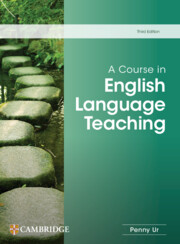Book contents
- Frontmatter
- Contents
- Acknowledgements
- Introduction
- 1 Teaching English today
- 2 The lesson
- 3 Classroom interaction
- 4 Tasks
- 5 Texts
- 6 Teaching vocabulary
- 7 Teaching grammar
- 8 Teaching listening
- 9 Teaching speaking
- 10 Teaching reading
- 11 Teaching writing
- 12 Feedback and error correction
- 13 Assessment and testing
- 14 The syllabus
- 15 Teaching/learning materials
- 16 Teaching content
- 17 Classroom discipline
- 18 Digital technology and online teaching
- 19 Learner differences 1: age
- 20 Learner differences 2: diversity and inclusion
- 21 Teacher development
- Glossary
- References
- Index
- Frontmatter
- Contents
- Acknowledgements
- Introduction
- 1 Teaching English today
- 2 The lesson
- 3 Classroom interaction
- 4 Tasks
- 5 Texts
- 6 Teaching vocabulary
- 7 Teaching grammar
- 8 Teaching listening
- 9 Teaching speaking
- 10 Teaching reading
- 11 Teaching writing
- 12 Feedback and error correction
- 13 Assessment and testing
- 14 The syllabus
- 15 Teaching/learning materials
- 16 Teaching content
- 17 Classroom discipline
- 18 Digital technology and online teaching
- 19 Learner differences 1: age
- 20 Learner differences 2: diversity and inclusion
- 21 Teacher development
- Glossary
- References
- Index
Summary
What is writing?
The teaching of writing has assumed much greater importance in recent years, since the use of the internet requires written input for search engines and works of reference, as well as rapid online written communication through text messaging, blogs and other social media.
Some characteristics of writing
Writing is fundamentally different from the other four skills. Most obviously it is associated with sight and (usually) movement, as contrasted with the auditory and oral characteristics of listening and speaking; and it is productive, as contrasted with the receptive skills of listening and reading. Other, less immediately obvious, characteristics are the following:
• It is permanent. A text, once written, normally remains there, on paper or on the screen, to be easily re-read or rewritten, either very soon after it was written or later. Speech, on the other hand, is normally fl eeting, with no possibility of changing and editing.
• It is dense. The content of a written passage is presented relatively densely, with little redundancy (pauses, repetition, fillers, paraphrases), as is typical of informal speech.
• It takes time. Writing takes longer than speaking, reading or listening, and also requires more deliberate effort. • It is asynchronous, or time-independent. We usually read text some time after it has been written. Even with synchronous chat, there is a time-lapse between production and reception. Spoken discourse is, in most cases, produced and received simultaneously.
• The person or people being addressed are not physically present. The target audience for a written text – whether a single addressee, closed group or the public at large – is rarely physically present, whereas spoken interaction is mostly face-to-face.
• It is a learnt form. Most people acquire the spoken language (at least of their own first language) intuitively, and may even learn to read on their own; whereas writing is normally taught and learned in school.
• It uses more standard forms. English speech typically varies widely, in accent, lexis and grammar, according to the cultural or linguistic background of the speaker; writing, in contrast, is more uniform and tends to observe more carefully the conventional grammatical rules of international English (see 1 Teaching English today).
- Type
- Chapter
- Information
- A Course in English Language Teaching , pp. 146 - 162Publisher: Cambridge University PressPrint publication year: 2024

